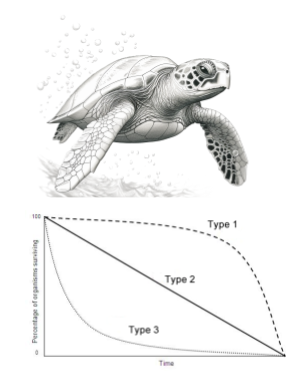
This case study focuses on survivorship curves and population models by examining a case about loggerhead turtles. The case starts off with a story about how beach visitors must follow certain rules to not disturb native turtles and nesting behavior.
Students watch a video that shows how biologists moved sea turtle nests after the BP Oil spill in 2010. From there, students learn about reproductive strategies (R -strategists and K-strategists), logistic growth curves, limiting factors and carrying capacity.
This study can be substituted for a traditional lecture on the topics, though instructors will need to pause and discuss certain concepts throughout the case.
Sea Turtle Reproductive Strategy
Type III survivorship curves are characterized by high mortality rates early in life, followed by increased survival as individuals reach maturity. This pattern precisely describes the survival trend of sea turtle hatchlings:
- High Mortality in Early Life: Sea turtle hatchlings face numerous challenges as they emerge from their nests and venture into the ocean. Predators, both on land and in the water, pose significant threats. Birds, crabs, fish, and various other predators prey on these vulnerable hatchlings, resulting in high mortality rates during the early stages of their lives.
- Increased Survival as they Grow: The survivors that manage to overcome these initial threats and reach a larger size exhibit a notably higher chance of survival. As they grow and develop, their survival rates increase, and they become more resilient to certain predators and environmental challenges.
- Stable Survival in Adulthood: Once sea turtles reach adulthood, their survivorship tends to stabilize, and their mortality rate becomes more consistent.
Grade Level: 10-12 | Time Required: 1.5 – 2 hours
HS-LS2-1 Use mathematical and/or computational representations to support explanations of factors that affect carrying capacity of ecosystems at different scales.
HS-LS2-2 Use mathematical representations to support and revise explanations based on evidence about factors affecting biodiversity and populations in ecosystems of different scales.
HS-LS2-7 Design, evaluate, and refine a solution for reducing the impacts of human activities on the environment and biodiversity.*

